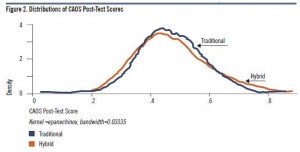
Test scores for statistics class comparing conventional and hybrid-online classes. (Click for more legible image.)
The University of Virginia, it seems, is one of more than a dozen prestigious universities to have signed a partnership with Coursera, a company that provides hosting services for massively open online courses (MOOCs). The deal was in the works even as UVa was roiled by controversy over the forced resignation of President Teresa Sullivan, one of whose alleged offenses was insufficient enthusiasm for online learning. Writes the Chronicle of Higher Education:
Ironically, at the time the board was plotting the Sullivan ouster, delegations of deans and faculty members from Virginia’s undergraduate college of arts and sciences and its graduate school of business were both talking to Coursera about collaborations that would put the university on the crest of the MOOC wave, along with Stanford and the others.
UVa wouldn’t be joining company with Stanford, Princeton and Duke if there weren’t compelling evidence to support the idea that MOOCs can, for some courses, help students master the subject matter as well as they could in a traditional classroom setting.
The latest evidence comes from a report, “Interactive Learning Online at Public Universities: Evidence from Randomized Trials,” published by Ithaka S+R, a nonprofit, higher-education think tank. In a trial of 605 undergraduates at six universities in New York and Maryland, half of the students were assigned to a traditional class on introductory statistics while the other took a hybrid course that supplemented online content created by Carnegie Mellon University with weekly meetings with instructors.
The findings: “Our main results provide compelling evidence that, on average, students learned just as much in the hybrid format as they would have had they instead taken the course in the traditional format—with “learning” measured in traditional ways, in terms of course completion, course grades, and performance on a national test of statistical literacy.”
Hybrid courses have higher up-front costs associated with preparing the online content. However, the smaller instructor-student ratio would permit significant savings over the long run. Using admittedly crude simulations, the authors estimated that compensation cost savings could run from 19% to 57%, depending on the teaching model employed.
Conclude the authors: “Vigorous efforts should be made to aggressively explore uses of both the relatively simple systems that are proliferating all around us, often to good effect, and more sophisticated systems that are still in their infancy. There is every reason to expect these systems to improve over time, perhaps dramatically, and thus it is not foolish to believe that learning outcomes will also improve.”


